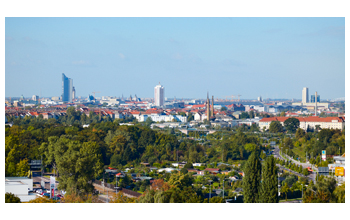Multimedia Gallery
Skyline of Leipzig, Germany
The skyline of Leipzig, Germany. Cities are growing around the world, and understanding how urbanization and urban gardening impact biodiversity and ecosystem services is increasingly important.
There are more plant species in cities in both the U.S. and Europe than in rural areas. Plant species in urban areas are more closely related to each other and often share similar functions. Consequently, urban ecosystems should be more sensitive towards environmental impacts than rural ecosystems. This is concluded by German and U.S. scientists based on a field study in Minneapolis, Minn., led by Jeannine Cavender-Bares, an associate professor at the University of Minnesota. The new study confirms results obtained by Sonja Knapp, a research scientist, and colleagues at the Helmholtz Centre for Environmental Research (UFZ) in a study on German flora in 2008. The new results have been published as a preprint in Ecology and have been highlighted in the renowned science magazine Nature.
To read more about this research, see the UFZ press release Live fast, die young. (Date of Image: September 2011)
Credit: Andre Kunzelmann, Helmholtz Centre for Environmental Research
Images and other media in the National Science Foundation Multimedia Gallery are available for use in print and electronic material by NSF employees, members of the media, university staff, teachers and the general public. All media in the gallery are intended for personal, educational and nonprofit/non-commercial use only.
Images credited to the National Science Foundation, a federal agency, are in the public domain. The images were created by employees of the United States Government as part of their official duties or prepared by contractors as "works for hire" for NSF. You may freely use NSF-credited images and, at your discretion, credit NSF with a "Courtesy: National Science Foundation" notation.
Additional information about general usage can be found in Conditions.
Also Available:
Download the high-resolution JPG version of the image. (1.6 MB)
Use your mouse to right-click (Mac users may need to Ctrl-click) the link above and choose the option that will save the file or target to your computer.

